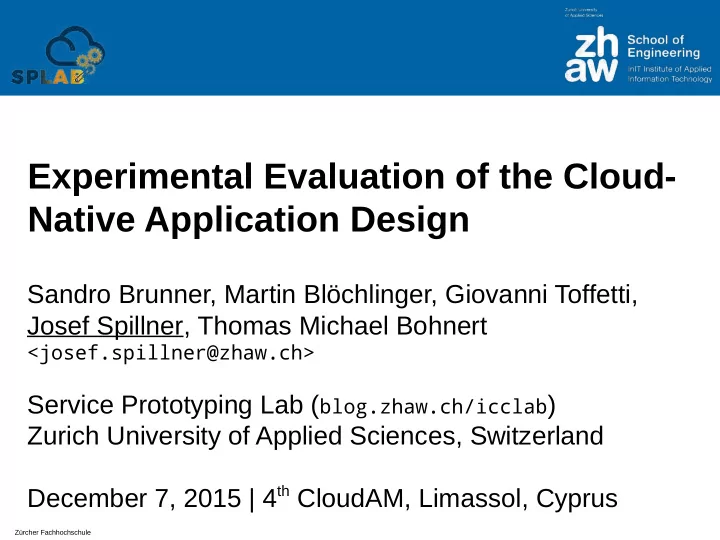

Experimental Evaluation of the Cloud- Native Application Design Sandro Brunner, Martin Blöchlinger, Giovanni Toffetti, Josef Spillner, Thomas Michael Bohnert <josef.spillner@zhaw.ch> Service Prototyping Lab ( blog.zhaw.ch/icclab ) Zurich University of Applied Sciences, Switzerland December 7, 2015 | 4 th CloudAM, Limassol, Cyprus Zürcher Fachhochschule
Cloud-Native Apps: Significant Trend! 2
Cloud-Native Apps: Definition (sort of) Software applications which ● fully exploit cloud features (APIs, infrastructure, platform, processes) ● are resilient against failures ● are elastically scalable ● run as services or end-user applications Implications ● design: fully redundant microservices, fully/partially redundant data ● technology: rapidly manageable units → containers 3
Cloud-Native Apps: Generic Design + discovery 4
Research Questions & Method CNA are scalable → Does it scale? CNA are resilient → Does it self-heal? How to find out: ● Using a typical business application: Zurmo CRM ● customer relationship management ● 3-tier architecture: web frontend, PHP backend, MySQL datastore 5
Experiment Architecture resilient scalable 6
Orchestrated Containers Setup 7
Containers in Operation 8
Conducting the Experiment Tools ● Tsung user load generator (to provoke scalability) ● performs web navigation randomly ● MCS-EMU: multi-cloud unavailability emulator (to provoke resilience) ● terminates Docker containers and VMs randomly, cf. ChaosMonkey, but with multiple (un)availability models Input functions: load, unavailability + configuration (3-10 VMs) 9
Conducting the Experiment Tsung load + discovery MCS-EMU terminations 10
Observations Output function assessment ● Tsung trace file ● Kibana dashboard views ● Zurmo application behaviour ● internal states: etcd, AWS dashboard, logs etc. Comparison with desired behaviour ● response times should remain +/- stable no matter what (for 3 VMs) 11
Observations with more (10) VMs 12
Findings (incl. delta to paper) Answers to Research Questions 1. Does it scale? → Yes, but: ● question of trigger metrics: external vs. application-internal ● still some startup overhead with containers 2. Does it self-heal? → Yes, but: ● tooling itself not resilient, random termination affects experiments ● deficiencies in standard software, e.g. MySQL clustering init ● container managers -- fleet in our case -- may misbehave, assumption is correct behaviour 13
Conclusions Evaluation: CNA design ● is effective & re-usable, if done right ● but: very tricky especially with used tooling ● alternative approaches: Kubernetes looks promising Re-usable contributions ● Dynamite scaling engine ● Testing tools ● Dockerised scenario application Code available! https://github.com/icclab/cna-seed-project Video available soon! (3 minutes demo cut) 14
'Methodology' + Lessons Learnt Step 1: Use case identification Step 2: Platform ● CoreOS bug: concurrent pull of containers from public hub ● Fleet bug: sometimes, containers are not scheduled for launch ● Docker bug #471: only partial download → failure cascade ● etcd restriction: cannot kill 3 member nodes → «Monsanto solution» ● etcd bug: no more requests accepted when disk full Step 3: Architectural changes ● outsourced session handling to cache + database in parallel Step 4: Monitoring ● new Logstash output adapter which forwards to etcd Step 5: Autoscaling ● Dynamite instructs Fleet for horizontal scale-out; is itself CNA 15
Recommend
More recommend